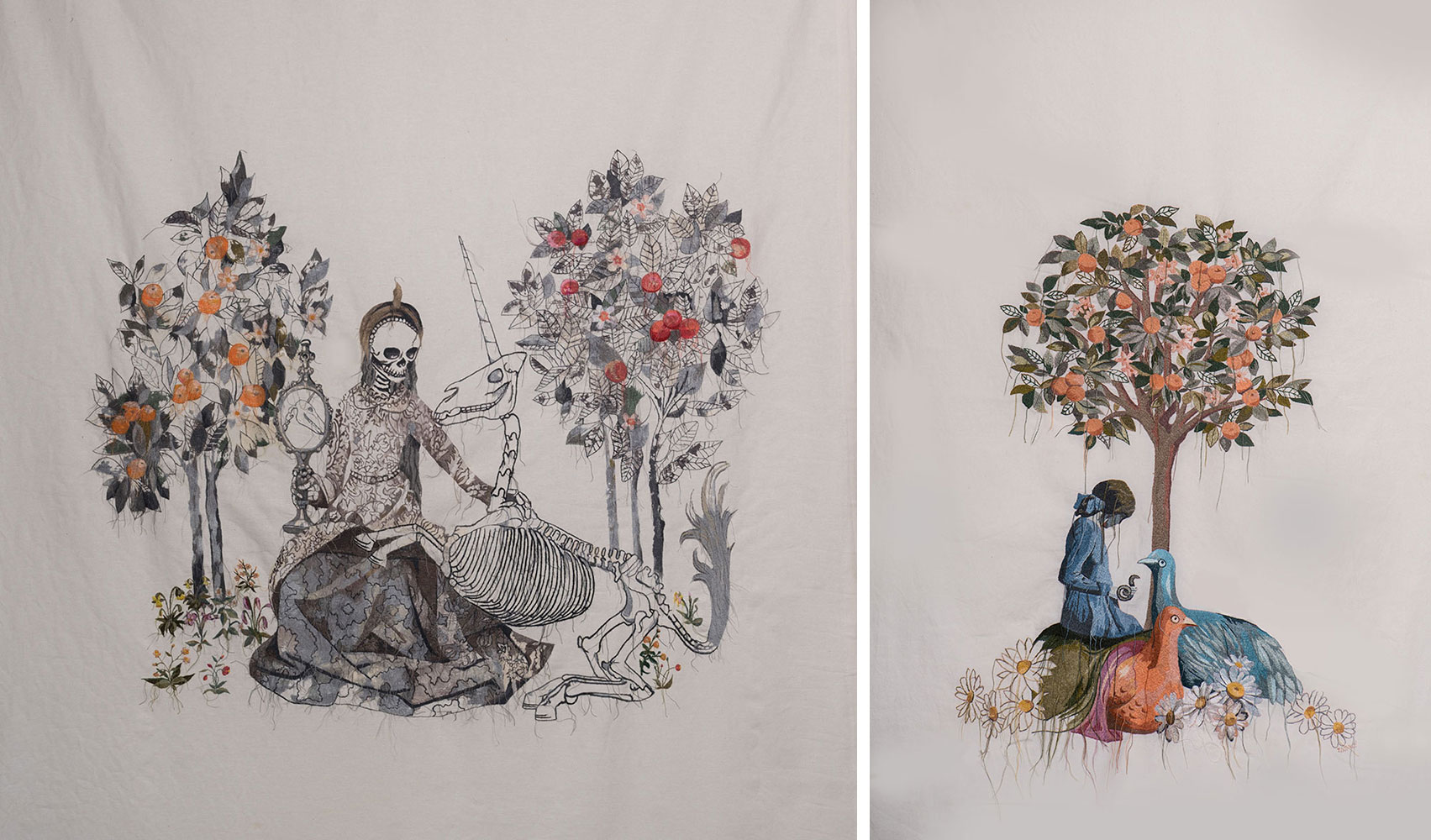INTERVIEW: Ifigenia Sdoukou
 The thread of conversations that is connecting me with Iphigenia Sdoukou is long, as we have a long story of collaboration till today, at the same time, we have delved into her work quite extensively. However, this time, on the occasion of her solo exhibition “Threads of Fantasy” at the Eκφρασι-Gianna Grammatopoulou Gallery in Athens, we attempt to focus on the power and dynamism of embroidery, which in her case is directly linked to painting, myths, and the narrative that is composed stitch by stitch on the canvas.
The thread of conversations that is connecting me with Iphigenia Sdoukou is long, as we have a long story of collaboration till today, at the same time, we have delved into her work quite extensively. However, this time, on the occasion of her solo exhibition “Threads of Fantasy” at the Eκφρασι-Gianna Grammatopoulou Gallery in Athens, we attempt to focus on the power and dynamism of embroidery, which in her case is directly linked to painting, myths, and the narrative that is composed stitch by stitch on the canvas.
By Efi Michalarou
Photo: Ifigenia Sdoukou
The title of your solo exhibition in Ekfrasi-Yianna Grammatopoulou gallery is “Threads of fantasy”. Would you like to connect for us the threads of painting, that your initial studies are, with embroidery? What is the thread that unites them?
I began as a painter. The art of embroidery come to the forefront when I started experimenting with various materials. I started stitching pieces of paper, thread and twigs on a canvas. Progressively, I arrived at embroidery. From the first time I experimented, I was amazed and absorbed. However, my main inspirations continue to come from paintings. I believe that I approach embroidery as a painter, because I think like a painter: the forms, the colors etc. Before I start to stitch one of my works, I first sketch it with great detail, because hand embroidery doesn’t forgive mistakes
We know that you love mythology and draw inspiration from it, as it is reflected in your work: mythical creatures, centaurs, Renaissance women, peacocks, ravens, unicorns, knights, and skulls. Is it a romantic world inspired by Italy and Florence, where you studied? How much did that particular environment influence you?
Certainly, the environment of Florence and renaissance art was a big influence; this is why the forms in my artworks resemble those of the late middle ages and early renaissance. At the same time though, I am influenced by literature, comics, period films and science fiction, western and eastern mythology and even traditional folk tales. I feel the need to present a mixture of thoughts, regarding gender, sexual and national identity, existential fears, cultural history, memory and pop culture, among other subjects.
You belong to the artists who use a traditional medium like embroidery in a very contemporary way for many years. How has this combination been achieved?
At one point I had read an article by journalist E. Tammy Kim, mentioning that arts relevant to textiles, such as embroidery, tend to become more popular during periods when women feel more anger. These forms of art, due to their standing in the household environment, can also provide a sanctuary from the “noise” of the outside world, from the things that give us anxiety and grief. I know that for me, embroidery is a form of meditation, something that requires my full focus. When I work, something beautiful, or sometimes angry and distressing, blooms on the fabric. Something that represents what I am and what I feel during that period. From the 70s, the barriers between embroidery and fine art have disappeared, allowing them to merge, with plentiful conceptualist results.
Having collaborated with you, I have been impressed not only by the variety of topics in your artwork, which, however, form a cohesive whole even when dealing with different subjects, but also the plethora of your production. How do you achieve this diversity, variety, and production, especially considering that many of the threads or fabrics are worked and processed personally by you?
Embroidery by hand is a quiet, slow and complex process. On the other hand, the treatment and dying of the cloth is something amusing and full of surprises. Every subject I study is a challenge and there are many challenges, like the need to be creative every single day. In an environment of multitasking, embroidery demands that we focus on only one thing, and this has tremendous benefits I read that the almost hypnotizing repetition that characterizes embroidery is very therapeutic, as each stitch calms the mind and lowers stress levels.
How significant is this process for you as an interconnected thread with nature in an era that our relationship with it has been disrupted?
The use of textile art is somewhat contradictory when we talk about the modern times and the threat of a dystopian future. In our times, uncertainty is inevitable. Climate change, war, pandemics, inequality, debt, corruption, potential unethical use of technology… The process of creating through embroidery provides short pauses in this situation, through the work with a more simple and earthly material.
Download Greek Version of the interview here
Info: Ekfrasi – Yianna Grammatopoulou Art Gallery, 9a Valaoritou str, Athens, Greece, Duration: 15/6-21/7/2023, Days & Hours: Tue, Thu-Fri 12:00-20:00, Wed 12:00-18:00, Sat 12:00-15:00, https://ekfrasi-art.com/
First publication: www.dreamideamachine.com
© Interview-Efi Michalarou

Right: Ifigenia Sdoukou, Daisy, 2022, fabric, hand-embroidery, 135 x 78 cm, © & Courtesy the artist

Right: Ifigenia Sdoukou, Lotus Eater, 2022, hand embroidery, 50 x 40 cm. (Haiku by Eleni Anastasopoulou), © & Courtesy the artist

